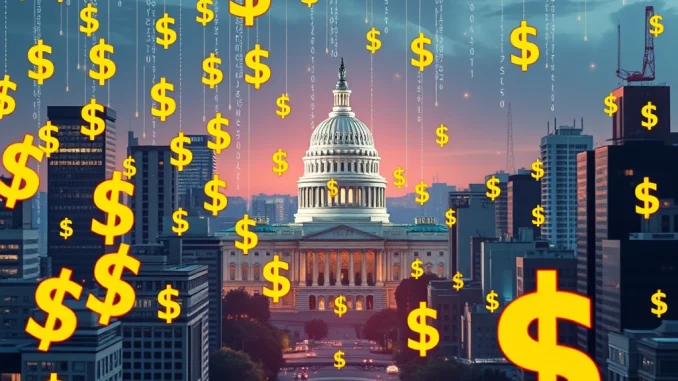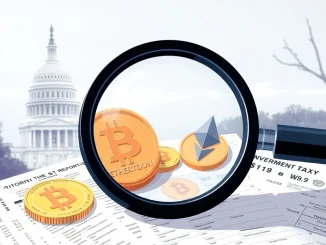
The cryptocurrency world is buzzing with a fresh call to action from a major industry leader. Brian Armstrong, the CEO of Coinbase, one of the largest crypto exchanges globally, is advocating for a significant shift in U.S. policy. He believes it’s time for the United States to empower consumers by allowing them to earn interest on stablecoins. This isn’t just a minor tweak; it’s a potentially game-changing move that could reshape the crypto landscape and benefit millions.
Why is the Coinbase CEO Pushing for Interest on Stablecoins?
Armstrong recently took to social media platform X to articulate his vision, emphasizing the need for proactive US stablecoin regulation. He argues that through clear and supportive legislation, the U.S. can unlock a plethora of advantages by permitting interest on stablecoins. But what exactly are these advantages, and why is this such a hot topic right now?
Let’s break down the core of Armstrong’s argument and explore why enabling interest on stablecoins could be a win-win situation for consumers, the global economy, and the United States itself.
The Three Pillars of Armstrong’s Argument: Why Interest on Stablecoins Matters
Armstrong outlines three key pillars supporting his stance on allowing interest on stablecoins. These aren’t just theoretical benefits; they are practical advantages that could have far-reaching implications:
- Benefits for U.S. Consumers: Imagine earning a yield on your digital dollars just like you might in a traditional savings account. For U.S. consumers, this translates to a new avenue for financial growth and passive income within the burgeoning digital economy. In a world where traditional savings account interest rates often struggle to keep pace with inflation, stablecoin interest could offer a compelling alternative.
- Global Dollar Utility: Think beyond U.S. borders. Armstrong highlights the potential for billions worldwide to utilize U.S. dollars in the form of stablecoins and earn interest on stablecoins. This dramatically expands the global reach and utility of the dollar. In regions with unstable local currencies or limited access to traditional banking, dollar-backed stablecoins earning interest could be a lifeline, offering stability and financial opportunity.
- U.S. Economic Advantage: Allowing interest on stablecoins isn’t just about consumer benefits; it’s about strengthening the U.S. economy. By fostering innovation and attracting capital within the crypto space, the U.S. can solidify its position as a leader in the digital finance revolution. This move could spur job creation, attract foreign investment, and enhance the competitiveness of U.S. financial institutions in the global market.
Unpacking the Benefits: How Does Interest on Stablecoins Actually Work?
Let’s delve deeper into each of these benefits to truly understand the potential impact of allowing interest on stablecoins.
Empowering U.S. Consumers with Financial Opportunities
For everyday Americans, the prospect of earning interest on stablecoins is enticing. Stablecoins, cryptocurrencies pegged to stable assets like the U.S. dollar, offer a way to hold digital currency without the price volatility often associated with other cryptocurrencies like Bitcoin or Ethereum. Currently, in many jurisdictions, regulations around earning interest on these assets are unclear or restrictive.
Imagine Sarah, a freelancer in New York, who receives payments in stablecoins. If regulations allowed, Sarah could potentially earn interest on those stablecoins while she holds them, increasing her earnings passively. This is similar to earning interest in a savings account, but within the digital asset ecosystem. This feature could be particularly attractive to younger generations who are increasingly comfortable with digital finance and seeking new avenues for wealth building.
Global Impact: The Dollar Goes Digital and Earns
Armstrong’s vision extends far beyond U.S. borders. He envisions a world where billions of people across the globe can access and utilize dollar-backed stablecoins, not just as a means of transaction, but as interest-bearing assets. This is particularly relevant in countries experiencing high inflation or economic instability. For example, in a country where the local currency is rapidly devaluing, holding savings in a dollar-pegged stablecoin earning interest on stablecoins can provide a much-needed shield against economic uncertainty and offer a more stable store of value.
This global accessibility to dollar-based assets earning interest could also foster greater financial inclusion, particularly in developing nations where access to traditional banking services is limited. Stablecoins can be accessed via smartphones, potentially bypassing the need for traditional bank accounts and offering a pathway to participate in the global financial system.
Boosting the U.S. Economy: Innovation and Leadership
Beyond consumer and global benefits, enabling interest on stablecoins could significantly benefit the U.S. economy. By creating a clear and supportive regulatory framework, the U.S. can attract innovation and investment in the burgeoning crypto space. Companies building stablecoin infrastructure, exchanges facilitating stablecoin transactions, and developers creating applications utilizing stablecoins are more likely to thrive and set up shop in jurisdictions with favorable regulations.
This influx of talent and capital can lead to job creation, technological advancements, and increased tax revenue for the U.S. Furthermore, by taking a proactive stance on US stablecoin regulation, the U.S. can solidify its position as a leader in the global digital economy, shaping the future of finance and ensuring that American companies and consumers are at the forefront of this revolution.
Navigating the Regulatory Landscape: What’s Next for Stablecoin Interest?
While the potential benefits are clear, the path to allowing widespread interest on stablecoins in the U.S. is not without its hurdles. Regulatory clarity is paramount. Currently, the regulatory landscape surrounding stablecoins in the U.S. is still evolving. There are ongoing discussions among various regulatory bodies, including the Securities and Exchange Commission (SEC), the Commodity Futures Trading Commission (CFTC), and banking regulators, about how to best classify and regulate stablecoins.
Armstrong’s call for US stablecoin regulation is timely and crucial. Clear legislation is needed to provide a framework within which stablecoin issuers and platforms can operate compliantly and confidently offer interest-bearing products. This legislation needs to address key aspects such as consumer protection, anti-money laundering (AML) compliance, and ensuring the stability and reserves backing stablecoins.
The Power of Stablecoins: A Financial Revolution in the Making?
The push to allow interest on stablecoins is more than just a technicality; it’s about unlocking the full potential of stablecoins and their transformative impact on the financial system. By allowing consumers to earn interest, the U.S. can foster greater adoption of stablecoins, enhance the utility of the dollar in the digital age, and position itself as a global leader in financial innovation.
Brian Armstrong’s advocacy is a powerful signal to policymakers. The time is ripe for the U.S. to embrace forward-thinking US stablecoin regulation that not only protects consumers but also empowers them to participate in the exciting future of digital finance. Enabling interest on stablecoins could be a pivotal step towards a more inclusive, efficient, and globally connected financial ecosystem, benefiting both U.S. citizens and the global economy as a whole.



